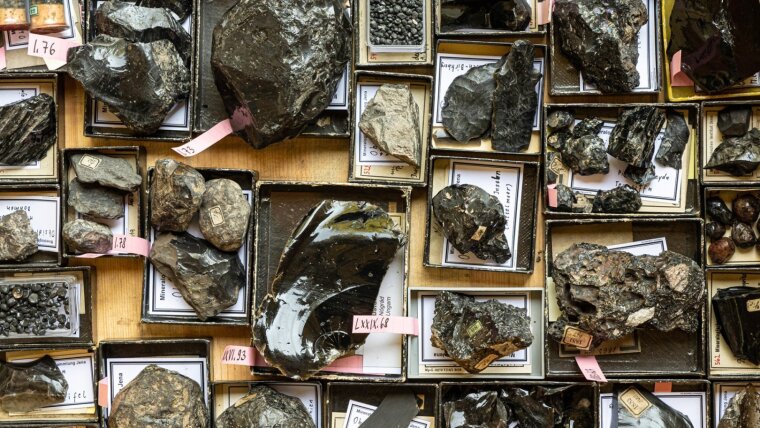
People have been making glass for thousands of years. However, numerous natural glasses are also formed, for example, by meteorite or lightning strikes. Dr Franziska Scheffler is a mineralogist who is studying natural glass that forms when lava shock-freezes or minerals get under pressure.
Interview by Laura Weißert
Portrait photo of Dr Fanziska Scheffler, mineralogist in the Bioactive Glasses working group at the Otto Schott Institute for Materials Research.
Image: Anne Günther (University of Jena)What is volcanic glass and how is it formed?
Volcanic glass is solidified lava that reaches the Earth’s surface when a volcano erupts. When lava cools slowly, it becomes rock because there’s enough time for small minerals to form, such as basalt or rhyolite.
But when lava cools quickly, for instance when a volcano erupts into the sea, it becomes volcanic glass such as obsidian. This is usually a deep black glass and when you hold it up to the light, it often gleams transparently. And when it falls on the floor, it shatters into sharp pieces like window glass.
You’re dealing with volcanic glass as part of a research project. What material are you studying exactly?
I’m not looking at classic volcanic glass in a common sense; I’m studying melt inclusions, which are tiny portions of lava that are entrapped in minerals and preserved as glass. They’re not necessarily of volcanic origin – they can also occur in metamorphic rocks when melting is involved.
The important thing that connects them is the fact they’ve been exposed to high temperatures and high pressures. One example is eclogite, a subduction related rock formed when an oceanic plate is subducted underneath another tectonic plate. If we look at such rocks, we can find indicators that have preserved the high pressure: the mineral composition on the one hand, and these small glass inclusions on the other.
What do you hope to achieve through your research?
I’d like to learn more about how those rocks were formed. The melt, solidified into glass, has preserved the pressure and temperature conditions from the time of its formation thanks to the mineral that surrounds it. I want to study the melt inclusions to reconstruct the pressure under which the rock was formed.
The objective of my investigation is to develop a kind of »geobarometer« that could be used not only to complete existing methods, but also to examine rocks whose composition was previously unsuitable for determining the pressure under which they were formed. And perhaps it could even be used to develop a method for determining the pressure in magma chambers – that would be a huge step for volcanic risk analysis.
How are you examining the melt inclusions?
Glass that cools under pressure shows changes in its material properties, because the chemical structures are compressed. We can use this by measuring the spectrum of the inclusion and then producing a glass of the exact same composition, applying certain pressure, and measuring that glass as well. This comparison allows us to estimate the pressure under which the glass was originally formed. In order to experimentally verify the effects of pressure, we’re using diamond indentation and high-pressure cell experiments.
What do you find most exciting about your research?
After studying mineralogy, I’m now working as a post-doc in the field of glass chemistry in material sciences. There are many similarities, but also a few differences. Now I have the opportunity to combine my strengths in mineralogy with my newly acquired knowledge of glass science. Mineralogy gives us a better understanding of crystalline solid matter, such as the structure of the Earth and its mountains. However, it also shapes technical progress and our daily lives – from semiconductor technology to the melt-in-the-mouth properties that chocolate is supposed to have.
What I find so exciting about glass research is the fact that I can produce my own lava in the lab furnace and then use it to make glass. The properties of the glass are determined by its composition and various other factors. There are hardly any limits and there’s about as much to be explored as there are elements and element combinations in the periodic table.
